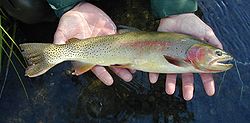- Yellowstone cutthroat trout
-
Yellowstone cutthroat trout 
Scientific classification Kingdom: Animalia Phylum: Chordata Class: Actinopterygii Order: Salmoniformes Family: Salmonidae Genus: Oncorhynchus Species: O. clarkii Subspecies: O. c. bouvieri Trinomial name Oncorhynchus clarkii bouvieri
(Jordan & Gilbert, 1883)Main article: Cutthroat troutThe Yellowstone cutthroat trout (Oncorhynchus clarkii bouvieri) is a subspecies of the cutthroat trout (Oncorhynchus clarkii) and is a freshwater fish in the salmon family (family Salmonidae) of the order Salmoniformes. Native only to a few U.S. states, their original range was upstream of Shoshone Falls on the Snake River and tributaries in Wyoming, also across the Continental Divide in Yellowstone Lake and in the Yellowstone River as well as its tributaries downstream to the Tongue River in Montana. The species is also found in Idaho, Utah and Nevada.[1]
The Yellowstone cutthroat trout is a prized game fish, with fly fishing the most popular angling method, since the subspecies feeds primarily on insects as adults, unlike introduced brown trout which are more piscivorous. Most varieties of cutthroat trout are less wary and selective than other trout species, thus angler success rates are higher.
Contents
Description
Yellowstone cutthroat can be distinguished from other cutthroat subspecies by their larger black spots, clustered towards the tail, and by their gray, gold, or copper hues. Spawning males, especially, typically wear golden brown colors. All cutthroats can be differentiated from rainbow trout by red, pink, or orange marking beneath the jaw that give the species its name.
Depending on habitat, Yellowstone cutthroat can range from six to twenty-six inches as adults, with six to ten inches common in high-elevation, high-gradient tributary streams and the largest fish found only in lakes or in spawning tributaries that feed lakes or emerge from them, such as the Yellowstone River in Hayden Valley in Yellowstone National Park. As a general rule, cutthroat in streams and small ponds run from ten to eighteen inches as adults, with a weight of one half to two pounds. Before habitat destruction, the threats presented by introduced species, and overfishing, they could run much larger, with fish over thirty inches reported, especially in the strain present in Heart Lake in the southeastern portion of Yellowstone National Park.
Reproduction
Regardless of habitat, all Yellowstone cutthroat trout require flowing water to spawn successfully. Ponds and lakes must have inlet or outlet streams for cutthroat for self-sustaining populations. Some fish are stocked in otherwise suitable lakes in the Beartooth Mountains and elsewhere to provide angling opportunities that otherwise would not be available.
Population threats
Their range has been reduced by overfishing and habitat destruction due to mining, grazing, and logging, and population densities have been reduced by competition with nonnative brook, brown and rainbow trout since these were introduced in the late 19th and early 20th centuries. However the most serious current threats to the subspecies are interbreeding with introduced rainbow trout (resulting in cutbows) in the Greater Yellowstone Ecosystem, the presence of lake trout in Yellowstone and Heart lakes in Yellowstone National Park which prey upon cutthroat trout to fifteen inches in length, and several outbreaks of whirling disease in major spawning tributaries[2].
Although lake trout were established in Shoshone and Lewis lakes in the Snake River drainage from U.S. Government stocking operations in 1890, they were never officially introduced into the Yellowstone River drainage and their presence there is probably the result of illegal introductions.[2][3]
Occasional drought in the Yellowstone area makes several spawning tributaries run dry in late summer, preventing cutthroat fry from migrating to Yellowstone Lake and making them easy prey for predators such as gulls, pelicans, and others. These threats have significantly reduced cutthroat populations in Yellowstone Lake and adjacent parts of the Yellowstone River. Currently, the strongest populations of cutthroat are to be found in the Grand and Black Canyons of the Yellowstone River and in the Yellowstone's major tributary in Yellowstone Park, the Lamar River and its tributaries. Attempts as recently as 2004 by environmentalists to have the U.S. Fish and Wildlife Service place the subspecies on the list of Endangered Species was not approved by the agency, citing evidence that major efforts are already underway to ensure the continued existence of this subspecies. All Yellowstone cutthroat trout caught within Yellowstone National Park must be released. Populations outside the national park are subject varying regulations depending on the location of the stream or waterway.
See also
- Angling in Yellowstone National Park
- Fishing in Wyoming
- Ecology of the Rocky Mountains
References
- ^ Gresswell, Robert E. (June 30, 2009). "Yellowstone Cutthroat Trout (Oncorhynchus clarkii bouvieri): A Technical Conservation Assessment" (pdf). U.S. Geological Survey. http://www.fs.fed.us/r2/projects/scp/assessments/yellowstonecutthroattrout.pdf. Retrieved 2011-11-04.
- ^ a b "The Yellowstone Lake Crisis: Confronting a Lake Trout Invasion" (PDF). National Park Service. 1995. http://www.nps.gov/yell/planyourvisit/upload/laketrout2.pdf. Retrieved 2007-03-19.
- ^ Kendall, W. C. (1921). The Fishes of the Yellowstone National Park. Washington D.C.: Department of Commerce, Bureau of Fisheries. pp. 22–23.
External links
Categories:- Oncorhynchus
- Cold water fish
- Yellowstone
- Fish of the Western United States
- Fly fishing target species
- Fauna of the Rocky Mountains
Wikimedia Foundation. 2010.

